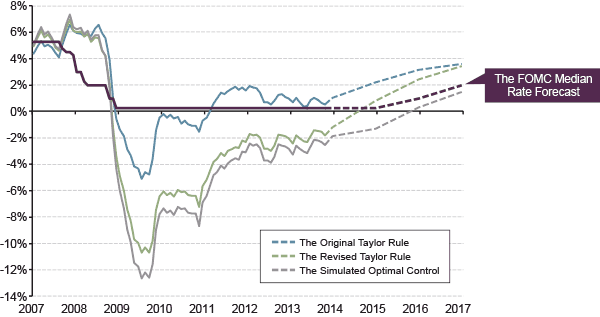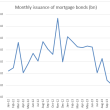The Fed and The Economy - "Don’t Shoot Until You See the Whites of Their Eyes"
by Scott Minerd, CIO, Guggenheim Partners LLC
November 20, 2013
The Federal Reserve has started to highlight “forward guidance” as a way to keep interest rates lower for longer – and get the exhausted hamster off the treadmill of quantitative easing. We still think tapering remains farther off than most investors expect.
Global CIO Commentary by Scott Minerd
On Tuesday evening at the National Economists Club, Federal Reserve Board Chairman Ben Bernanke stressed the importance of communication and the power of signals from the Fed to move financial markets. As if to underscore his message, today’s release of the Oct. 29-30 Fed minutes triggered more market speculation about whether the Fed might taper its asset purchases sooner rather than later. One thing is clear, distilling Fed policy into an understandable message is easier said than done. My view is that the Fed is highly sensitive to economic data and that stable employment growth and economic momentum remain elusive, suggesting that tapering remains farther off than most investors expect.
We cannot keep looking to the future for the economic growth needed to slow quantitative easing today. In June, when Dr. Bernanke raised the prospect of reducing accommodation, interest rates spiked violently and housing activity began to stall. So, the new math at the Fed seems to revolve around ending quantitative easing without another spike in interest rates. The equation of the day would substitute stronger guidance about the future path of interest rates (“forward guidance”) for asset purchases.
In either case, the likely incoming Fed Chairman Janet Yellen has made clear that she needs concrete signals that the economy is back on track before she will consider tapering. Dr. Yellen has essentially told markets, let’s not fool ourselves – let’s wait until we actually see the whites of the expansion’s eyes. The bottom line is that low rates should persist for at least another two or three years. It is also very likely that in the coming months the Fed will commit to keeping short-term rates lower for longer, so it can slow the wheel enough to allow the hamster to get off the endless treadmill of asset purchases.
Chart of the Week
Ultra-Low Fed Funds To Continue Under Yellen
An April 2012 speech by Dr. Janet Yellen, set to be the next chairman of the Federal Reserve, may provide clues for the Federal Open Market Committee’s (FOMC) future monetary policy stance. In the speech, she introduced three methods to project the optimal federal funds rate, and suggested that a revised Taylor Rule and the “optimal control” approach were her preferred methods. Based on FOMC projections from September, the median rate forecast suggests a first interest rate hike in mid-2015, later than what would be appropriate under the original and revised Taylor Rule. The Fed’s rate forecast implies that the optimal control method, which suggests a first rate hike in early 2016, is exerting growing influence on FOMC members’ views.
FUTURE PATHS OF FED FUNDS RATE*

Source: Bloomberg, Goldman Sachs, Guggenheim Investments. Data as of 10/31/2013. *Note: The original Taylor Rule measures the optimal interest rate in response to changes in inflation, output, and other economic conditions. The revised Taylor Rule uses the same formula, but increases the values of parameters for converting the unemployment gap into the output gap. The optimal control method chooses the interest rate to minimize the loss function of unemployment and inflation, which is structurally different than the Taylor Rule. Goldman Sachs derived a simplified approach to simulate the optimal control path and we reproduced their conclusions here. Projections are based on FOMC’s median forecast for key economic variables through 2016.
Economic Data Releases
Retail Sales Strong in October, Other Data Weak
- Retail sales rose more than expected in October, growing 0.4% after remaining unchanged in September. Nine of 13 categories showed increased sales.
- Existing home sales dropped to an annualized rate of 5.1 million in October, a 3.2% decrease and the lowest since June.
- Industrial production decreased 0.1% in October after rising the previous two months.
- The Empire Manufacturing index dropped to -2.21 in November, the fourth consecutive decrease and the lowest level since January.
- The NAHB housing market index was unchanged in November at 54.
- Mortgage applications fell 2.3% for the week ended November 15th, but purchase applications increased.
- The CPI ticked down 0.1% in October, and the year-over-year reading fell to 1.0%, the lowest in four years.
- Wholesale inventories rose for a third straight month in September, up 0.4%.
Expectations for Improved Growth in Europe, Japanese Exports Jump
- Euro zone CPI was unchanged in the October final estimate, remaining at a four-year low of 0.7%.
- The euro zone trade surplus widened from €6.9 billion to €13.1 billion in September.
- The euro zone ZEW survey increased to 60.2 in November, the highest since March 2006.
- The ZEW survey of investor expectations in Germany rose to 54.6 in November, a four-year high.
- Japanese exports accelerated to 18.6% year-over-year growth in October, the fastest since July 2010 and the fourth consecutive month of faster growth.
Copyright © Guggenheim Partners LLC
















